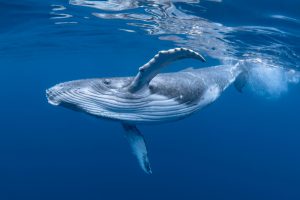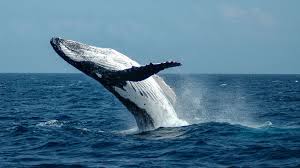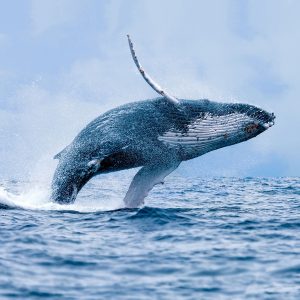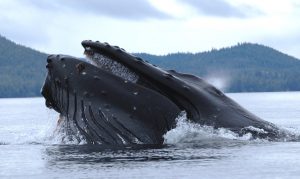Podcast: Play in new window | Download (Duration: 16:01 — 18.5MB)
Thanks to Clay for suggesting the topic of this week’s episode, the humpback whale!
Happy birthday to Emry!
Further reading:
How humpback whales catch prey with bubble nets
Study: Humpback whales aren’t learning their songs from one another
Stanford researchers observe unexpected flipper flapping in humpback whales
Ancient baleen whales had a mouthful
The humpback’s long, thin flippers help it maneuver:

Humpbacks are active, jumpy whales:


A humpback whale’s big mouth:

Show transcript:
Welcome to Strange Animals Podcast. I’m your host, Kate Shaw.
Thanks to Clay for suggesting this week’s topic, the humpback whale!
But first, we have a birthday shout-out! A great big happy birthday to Emry! I hope your birthday is so epic that in the future, when people look up birthday in the dictionary, your name is listed there.
I’m amazed we haven’t talked about the humpback whale before because when I was little, it was my favorite whale until I learned about the narwhal. Sorry, humpback, you’re now my second favorite whale.
The humpback is a baleen whale, specifically a rorqual, which is a group of related baleen whales. I don’t think I’ve mentioned the term rorqual before because I find it really hard to pronounce. Rorquals are long, slender whales with throat pleats that allow them to expand their mouths when they gulp water in. We talked about this in episode 211 about the fin whale, which is another rorqual. I’ll quote from that episode to explain again what the throat pleats are.
A baleen whale eats tiny animals that it filters out of the water through its baleen plates, which are keratin structures in its mouth that take the place of teeth. The baleen is tough but thin and hangs down from the upper jaw. It’s white and looks sort of like a bunch of bristles at the end of a broom. The whale opens its mouth wide while lunging forward or downward, which fills its huge mouth with astounding amounts of water. As water enters the mouth, the skin stretches to hold even more, until the grooves completely flatten out.
After the whale fills its mouth with water, it closes its jaws, pushing its enormous tongue up, and forces all that water out through the baleen. Any tiny animals like krill, copepods, small squid, small fish, and so on, get trapped in the baleen. It can then swallow all that food and open its mouth to do it again. This whole operation, from opening its mouth to swallowing its food, only takes six to ten seconds.
The humpback mostly eats tiny crustaceans called krill, and little fish. Since gulp feeding takes a lot of energy, finding a lot of food in a relatively small space is important to the whale. Many little fish that live in schools will form what are called bait balls when they feel threatened, where the fish swim closer together and keep moving around. Any given individual fish has a good chance of avoiding being eaten when behaving this way. Think about last week’s episode, where the spinner shark swims straight up through a bait ball, biting biting biting. It eats some fish, but most are fine. But a big filter feeder like the humpback can gulp a whole lot of fish at once, so it really likes bait balls.
To help maneuver prey animals into a small area, groups of humpbacks sometimes employ a strategy called bubble-net feeding. The whales will dive below the fish or krill and swim in a ring, blowing bubbles the whole time. The bubbles startle the animals, who move away from them. But since the bubbles are all around them, and the whales swim closer and closer together so that the ring of bubbles shrinks, eventually the fish or krill are all clustered in a small space as though they’re caught in a net. Then the whales open their mouths and gulp in lots of food. This is actually a simplified explanation of how bubble-net feeding works, which requires several different types of bubbles and various actions by the whales to make it work right.
The humpback is closely related to the fin whale and the blue whale. In episode 211 we learned that fin and blue whales sometimes interbreed and produce offspring, and in at least one case a marine biologist identified a whale that appeared to be the hybrid of a blue whale and a humpback.
The humpback grows up to 56 feet long, or 17 meters, with females being a little larger than males on average. It’s mostly black in color, with mottled white or gray markings underneath and on its flippers. Its flippers are long and narrow, which allows it to make sharp turns. It also has tubercles on its jaws and the fronts of its flippers which are probably sensory organs of some kind, since they contain nerves attached to a very thin hair in the middle that’s about an inch long at most, or almost 3 cm.
This is a good time to remind you that even though they look very different from other mammals, all whales are mammals. Mammals are warm-blooded animals that produce milk for their babies. Mammals also have hair, unless they don’t have hair, except that the humpback whale does have hairs in its tubercles. So there you go, humpback whales have hair.
Despite its huge size, the humpback is an active whale. It frequently breaches, meaning it rises up out of the water almost its full length, then crashes back down into the water with a huge splash. It also often slaps its flippers or its tail on the surface. Some researchers think these behaviors may have something to do with communication with other whales, or that the whale is trying to get rid of parasites, or that the whale is just having fun.
Humpback whales are famous for their elaborate songs, which are produced by males. The whales breed in winter, and the males start singing as winter gets closer, so the songs must have something to do with mating season. Scientists aren’t sure what, though. Females don’t seem to be very interested in individual males who are singing, but they will sometimes be attracted to a group of singing males. Some researchers suggest that singing might be a general call to attract all whales in the area to the breeding grounds. Then again, sometimes a male will interrupt another male who is singing and the two will fight.
The songs vary and new song elements can spread quickly through a population. Generally, researchers think males hear a new element and incorporate it into their own songs, but results of a study published in 2021 found that similar new song elements often show up in whales that could not have heard other whales sing it. This indicates that instead of copying other songs, each whale modifies his own song individually and sometimes the changes are similar. That’s just one study, though. It’s probable that the way males change their songs depends on many factors, only one of which is hearing and imitating other songs.
The study suggests that the way we think about whale songs might be wrong to start with. Researchers generally think that a whale probably sings for the same reasons that birds sing: to stake out a territory, to advertise to potential mates that it’s healthy enough to spend energy singing, and to warn rivals away. But because whales live in an environment so different from birds, and so different from what we as humans understand, it’s possible that whalesong carries meanings and intentions that we can’t interpret. A different study published in 2019 discovered that male humpbacks sometimes sing in feeding grounds, especially when a population of whales decides to overwinter at their feeding grounds instead of migrating, as sometimes happens.
What, precisely, a whale’s song means to other whales is something that only the whales know for sure. This is what a humpback song sounds like:
[humpback song]
Humpbacks make other sounds other than songs, though. Mothers and calves need to communicate so that the calves get the care they need and don’t stray too far away, but since any sounds could attract predators, they have to communicate very quietly. They make little grunting sounds to each other.
The main predator of the humpback whale is the orca, which will attack and kill calves and sometimes even adults. As a result, the humpback really does not like orcas. Humpbacks will sometimes protect seals and other animals from orca attacks.
Humpbacks migrate from their summer habitats in either the Antarctic or the Arctic, depending on what hemisphere they live in, to their winter breeding grounds in tropical waters. Then they return to colder waters in summer where there’s more food, since krill is a cold-water species. These migrations can be as long as 5,000 miles, or 8,000 kilometers. Unlike some animals that migrate in huge herds, humpbacks mostly travel in small groups that are often widely spaced.
The humpback was almost driven to extinction by commercial whaling, but after it was declared a protected species, its numbers have increased. It still has the same human-caused dangers that many other marine animals face, including habitat loss and water pollution, climate change, drowning after being entangled in nets, and noise pollution that can keep whales from communicating.
There’s always a lot we don’t know about any given species of whale, since whales are hard to study. For instance, a 2017 study discovered that humpbacks sometimes swim in a way never documented in whales before. Whales swim by flexing their massively powerful tails, and use their flippers to maneuver. Think of the tail as the engine of a car and the flippers as the power steering system. The humpback’s flippers are uniquely shaped, which as we mentioned earlier means it can maneuver skillfully, turning much more quickly than a great big whale would otherwise be able to turn. But in video studies of whales in the wild, very rarely a whale would flap its flippers like a bird flapping its wings—or, more accurately, like a seal or sea lion swimming with its flippers. The researchers who analyzed the videos suggest that the flapping is used for accelerating quickly, and because it takes a lot of energy, the whales don’t do it often. The researchers also think the humpback may be the only whale species that can accelerate using the motion of its flippers, since other whales have much smaller flippers relative to their size.
As far as we know, baleen whales don’t use sonar the way toothed whales do. Their songs and sounds are for communication, not navigation. But while humpbacks mostly hunt for food near the surface of the water where there’s plenty of light, they do occasionally dive deeper and hunt for food near the bottom. They especially like an eel-like fish called the sand lance, which spends a lot of time buried in the sand on the sea floor. In 2014, a study of humpbacks diving to find these fish indicated that when a whale dives alone, it remains silent, but when it dives to hunt with some friends, they communicate with a sound described as a tick-tock. Not the app, just a sound like the ticking of a clock. Sometimes more humpbacks come to join the whales when they hear their tick-tock sounds. But we still don’t know how the whales find the fish in the first place, since there’s no light for them to hunt by. It’s possible they can detect the fish’s chemical signature in the water when they’re close enough to one.
Baleen whales don’t have teeth, although when a baby whale is developing in its mother’s womb it does grow teeth. But at some point during its development, these embryonic teeth are reabsorbed and baleen plates form instead.
The extinct ancestors of modern baleen whales still had teeth. One genus was called Aetiocetus, which lived between about 34 and 23 million years ago in the north Pacific Ocean. It probably wasn’t directly related to modern whales, since baleen whales do actually appear in the fossil record before Aetiocetus. It was a small whale that probably only grew about 11 feet long, or 3.5 meters, although some species might have grown twice that length. The first Aetiocetus fossils were discovered in the 1960s and it was initially described as a toothed whale, since it had teeth.
But not everyone agreed. Aetiocetus showed some adaptations to filter feeding seen in modern baleen whales. For instance, its lower jaw bones weren’t fused at the chin end as they are in toothed whales. Modern baleen whales don’t have connected lower jaw bones, and in fact they have a sensory organ at that spot that scientists think helps the whale keep from engulfing too much water and hurting itself.
Recently, a team of scientists examined a CT image of a skull of Aetiocetus weltoni and discovered something surprising. Baleen is made of keratin, and keratin is only preserved in fossils very rarely, but in baleen whale fossils, the upper jawbones do show grooves where the baleen once connected. These grooves were present in the Aetiocetus skull, even though it also had teeth.
Researchers think Aetiocetus may have used its teeth to filter larger fish from the water the way some animals like crab-eater seals do today. Its teeth interlocked, which would allow it to trap fish in its mouth while pushing water out between its teeth. Its baleen probably helped catch smaller fish and other animals. The baleen was far enough away from the teeth that the whale would have still been able to bite at fish and other prey without accidentally biting its own baleen. But, as the researchers mention in their 2021 paper, Aetiocetus had a really crowded mouth.
You can find Strange Animals Podcast at strangeanimalspodcast.blubrry.net. That’s blueberry without any E’s. If you have questions, comments, or suggestions for future episodes, email us at strangeanimalspodcast@gmail.com. If you like the podcast and want to help us out, leave us a rating and review on Apple Podcasts or Podchaser, or just tell a friend. We also have a Patreon at patreon.com/strangeanimalspodcast if you’d like to support us for as little as one dollar a month and get monthly bonus episodes.
Thanks for listening!